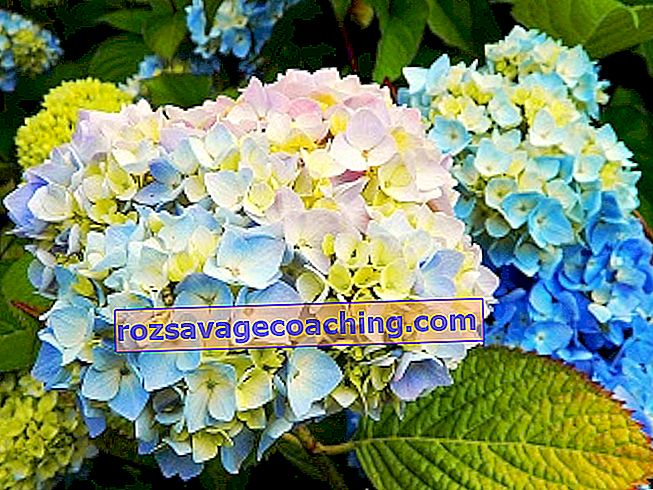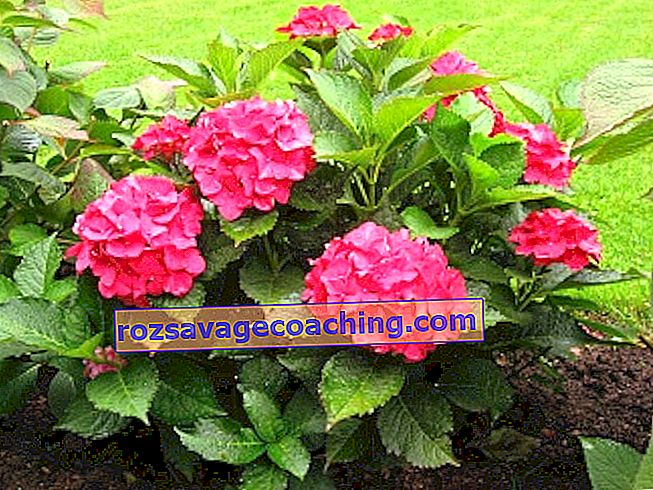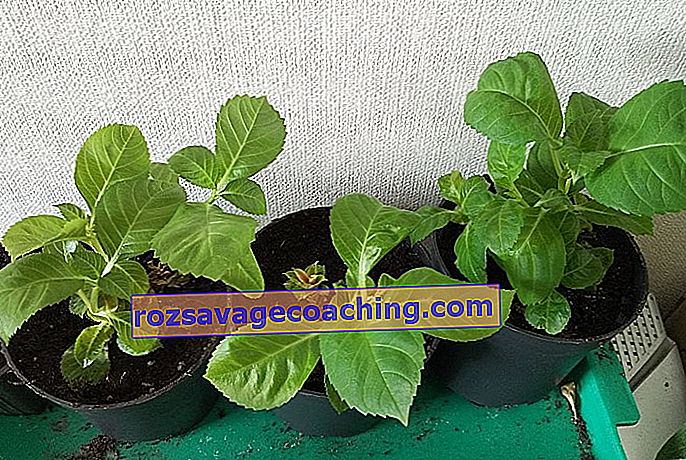
Garden hydrangea is a decoration of any personal plot. However, few people know that this decorative flower has indoor varieties that can be grown at home.

Description
Hydrangea is classified as a perennial flowering shrub. The plant is a multi-stemmed bush with leaves of a bright green hue. The flowers are large and barren, or small but fruiting.
The inflorescences of a potted hydrangea look like large balls. Their colors can be snow-white, as well as lilac, pinkish, light green and even cream - the color is influenced by the pH of the substrate. For example, alkaline soils give the flowers pink and lilac colors, sour ones make the flowers of indoor hydrangea bright blue, and neutral earth gives a white or beige tone. By the way, the sepals give the main beauty and tone to the inflorescences - the flowers of this culture themselves are colorless.




Hydrangea is often found in gardens, but with careful care it successfully grows and develops at home.
A pot culture grows up to 1 m, while on each bush from 1 to 8 large inflorescences are formed, which grow immediately above the upper leaves of the shoots. The size of the blooming ball reaches 30 cm, while the smaller the number of inflorescences, the larger each of them.


Feng Shui supporters give home hydrangea special properties, namely:
- it is believed that hydrangea reduces hostility, softens the conflicting disposition of households;
- promotes the creation of warm family relationships, helps spouses to reach mutual understanding;
- contemplation of this decorative bush relieves mental fatigue, relieves stress after a stressful situation or an unpleasant incident, helps to calm down;
- a flowering plant helps to get rid of bad moods, neutralizes negativity and eliminates bad thoughts.



How is it different from the garden one?
It is not difficult to distinguish a home hydrangea from a street one - the home variety is more miniature, but at the same time its color is much more intense.
With regard to care, the requirements of the room culture are no different from the garden one. However, there are several factors that a florist should be aware of.
- Flowers planted in open ground must be hidden from drafts and direct sunlight. At home, plants are reliably protected, so they can be grown almost anywhere.
- When watering a room hydrangea, it is imperative to keep the amount of water flowing to the flower under control, since its roots are more susceptible to decay.
- In the garden, you can grow several varieties of hydrangea at once, at home it is not recommended to plant different varieties in one container.


In all other respects, caring for a street hydrangea and a room one does not have any differences.
Common varieties
At home in pots, you can grow exclusively large-leaved crops. This variety has over 100 varieties that can have a wide variety of colors.
Hydrangeas varieties of blue and light blue:
- Ramars Mars - small bushes with small inflorescences, the diameter of which usually does not exceed 18-20 cm;


- Airlie Blue is a tall shrub with deep blue flowers.


Varieties with red and pinkish flowers.
- "Red sensation" - this hydrangea is distinguished by rich burgundy-scarlet flowers. After applying iron-containing fertilizers to the ground, it changes its color to red-purple.


- "Europe" is a rather tall pink hydrangea. The stem length is 40-55 cm.The shrub blooms profusely, the flower diameter is 5-7 cm, the size of the inflorescence is 20-25 cm in diameter.

- "Hamburg" - the length of the stems is 35-45 cm. It blooms very luxuriantly, the diameter of the flower is 4-5 cm.

Varieties with white and creamy inflorescences.
- Souer Tharese is an early flowering hydrangea. The variety is undersized - the height of the stems does not exceed 40 cm, the diameter of the inflorescences is 14-16 cm.

- M-me E. Mouillere is a very unusual hydrangea with narrowed graceful leaves. The flowers are small - 2-4 cm.The size of the inflorescences in the cross section is 18-20 cm.


- "Goliath" is perhaps the tallest potted hydrangea, growing up to 65-70 cm. Sepals have decorative, as if incised edges, snow-white inflorescences acquire a pink color by the end of flowering.


- The jasmine hydrangea looks very impressive - a low-growing bush with delicate snow-white flowers.



Landing
If you are going to grow a hydrangea in an apartment, then keep in mind that immediately after purchase, and then at least every 3-4 years, it must be transplanted - this is the limiting time of its life as a home plant.
Each time after this period, it should be planted again. It is best to replant the hydrangea annually - this will ensure lush flowering.


Keep in mind that the roots of this shrub grow quite strongly over the year, so each new container should be slightly larger and more voluminous than the previous one.
The substrate is made up of the following ingredients:
- turf soil - 4 parts;
- deciduous soil - 2 parts;
- peat - 2 parts;
- river sand - 1 part.
Manure and humus are dangerous for hydrangeas.


It is best to transplant this shrub using the transshipment method. This method will minimize stress for the green pet. The process is extremely simple: drainage is laid out on the bottom of the new pots, after which the bush, along with the earthen lump, is carefully pulled out of the pot, transplanted into a new one, and the remaining volume is filled with the prepared substrate so that the root neck of the hydrangea is located above the earth layer. The transplanted plant should be watered abundantly and sprinkled with peat (it retains moisture inside the container).

Follow-up care
Home hydrangea cannot be called an unpretentious culture, this flower is extremely picky about the conditions of its maintenance and compliance with the requirements for caring for it. The most difficult thing is to maintain the necessary cyclical development of the pot culture - this flower must be looked after, starting from the stage of bud formation and throughout the growing season. It is extremely important to create favorable conditions for the wintering of hydrangeas.
Keep in mind - the flower is classified as a deciduous plant, therefore, even at room temperature, leaf plates are not preserved.

In the dormant stage, the plants shed their leaves, at this time they should be ensured to stay in a dark, cool place, adjust the watering regime and exclude the introduction of fertilizers. The "wintering" lasts from mid-December to February. With the onset of spring, the bush wakes up and quickly grows.

Lighting
Hydrangea is very demanding on lighting, this applies to both outdoor and indoor varieties. The plant prefers light, but at the same time protected from direct sunlight. It is advisable to place the bush a couple of meters from the south or southeast window. If the plant stands under direct ultraviolet rays, this will lead to a loss of decorativeness of the green mass and jeopardize the appearance of flowers.
Throughout the day, the amount of light should remain the same, therefore, a decrease in natural light in winter can have the most detrimental effect on the condition of the flower. With a decrease in daylight hours, the flower should be moved to a brighter place or use artificial lighting. If this is not done, then the hydrangea will simply weaken and be vulnerable to pests.


Keep in mind that in addition to good lighting, home hydrangea needs a sufficient amount of fresh air, because the room where it grows and develops should be regularly ventilated, but so as not to create drafts. In the spring-summer period, the potted hydrangea feels good in pots located on loggias and balconies with a little shading, as well as in cool areas of the garden.



Watering
In winter, when the flower goes into the dormant stage, it can be left at a temperature of 4-9 degrees. This indoor culture can be sent to winter on a loggia or a glazed balcony, as well as in a cellar or basement. The shoots must be cut by 2⁄3, and then the bush must be covered with coniferous needles or wrapped with agrofibre.
If the shoots wither away, do not worry: with the onset of spring, the hydrangea will completely recover quite quickly, it will begin to grow overgrown with new leaves and bloom. The comfort of the temperature background for hydrangea can be indicated by its green leaves; if they began to turn yellow, therefore, it is too hot in the house for the bush.


In addition to coolness, hydrangeas need a fairly high air humidity.
In order to maintain its optimal level, you can use a special device - a humidifier, or you can put a small saucer of water near the pot, or lay out the tray with moistened moss.
Hydrangea is classified as a water-loving plant, therefore, during the stage of active growth and in the flowering stage, it must be watered abundantly, observing the following rules:
- the area of soil near the roots should be moistened all the time, but at the same time the topsoil should dry out thoroughly before irrigation;
- in the dormant stage, the frequency of watering must be gradually reduced; in winter, humidification is reduced to taking care that the earthy lump does not dry out;
- as soon as young foliage appears on the bush in spring, the frequency and intensity of watering should be gradually increased;
- for irrigation, it is better to take soft filtered or settled water, always at room temperature.

Fertilizers
During the entire growing season, hydrangeas need regular feeding. Fertilizers are applied a couple of times a month from February to November. Top dressing is extremely important for hydrangeas. The fact is that this decorative flower requires careful care, only in this case the bush will be strong, strong and able to resist diseases.
Timely feeding stimulates the abundant appearance of buds, makes the inflorescences larger, the flowers - bright, and the flowering process itself is long. In addition, depending on the composition of the dressings, you can achieve a change in color shades.


The first feeding is done in February. It is aimed at the active formation of the green mass of the shrub. It is best to use nitrogen-containing preparations at this stage.
In the spring, top dressing ensures the release of flower stalks and the emergence of buds. At this time, the plant responds well to potassium. Foliar feeding also has a good effect, so it will be useful to additionally spray the bush with a pale solution of potassium permanganate.

Summer top dressing helps hydrangeas to continue active flower formation and maintain long-term flowering. Complex preparations do the best with this.
In late summer, nitrogenous fertilizers are best avoided. At this stage, flower growers advise using non-traditional dressings based on sour bread and dairy products.
With the onset of autumn, the plant will need potassium-phosphorus fertilizers. It is best to use peat or compost - hydrangeas need them in order to build up strength before going into the dormant stage.

How to transplant into open ground?
If desired, the potted hydrangea can be transplanted outside. It is advisable to do this in the spring, immediately after the threat of return frosts has finally passed and the earth has completely warmed up. At this moment, the plants easily tolerate the transplant, since they are still in a dormant state.
However, you can transplant a flower in the summer, and in the southern regions of Russia even in the first half of September . For the time remaining before the onset of winter cold weather, the bushes will have time to take root in a new place.
It is advisable to transplant the hydrangea using the transshipment method. To do this, the root system is simply removed from the container along with an earthen clod and moved into the ground, where it will have enough space for growth and further development.


The site for planting is always open and sunny. But remember that bright light and drafts have a detrimental effect on this flowering shrub.
With the scorching sun for hydrangeas, they will certainly organize light shading. Keep in mind that the presence of sunlight in the morning is important for the culture, so it is advisable to choose the east or southeast side for planting. Hydrangea can be planted in light partial shade, but in this case the flowering will not be so abundant.

Disease and pest control
Like any other cultivated plant, the potted hydrangea often encounters diseases. In most cases, downy mildew and gray mold become the cause of flower wilting . They infect the bush with excessive moisture. For the resuscitation of a flower at the first infection, treatment with Bordeaux liquid is shown, with repeated it is better to use preparations based on copper.
Emerging aphids are removed with a concentrated solution of laundry soap, "Aktellik" or "Karbofos". To kill the tick, they are also treated with soapy water. Both pests usually appear when the air is excessively dry.

With low humidity and in conditions of lack of watering, yellowing of the plant is often observed. It can also be the result of a nitrogen deficiency or an excess of alkalis in the soil.
With a deficiency of nutrients, the hydrangea dries up. In this case, fertilization is necessary. The reasons why the tips of the leaf plates begin to dry at home hydrangea can be several at once: this is a weak air humidity, poor watering, and also drafts.
Lack of flowering usually occurs if the plant has not rested during the winter months in a cold, dark room. Even if the bush looks healthy, its leaves have not fallen off, and the branches have not dried up, it still needs to rest and gain strength. If you leave the plant awake, it will lack the vital energy to release flower stalks.
Often the leaves on the bushes turn yellow because it is a deciduous crop, and for them it is the norm to fall off in the autumn.

Reproduction
Homemade hydrangea can be propagated by cuttings, layering, as well as dividing the bush and seeds. The latter method is ineffective, therefore it is used mainly by breeders to create hybrid varieties.
The easiest option is to breed by cuttings. To do this, in the spring, it is necessary to cut the shoots into small pieces of 8-9 cm so that 2-3 nodes remain on each. The cuttings are kept in a solution of "Kornevin" or any other root stimulator, then placed in the ground to form a root system.
A similar method is propagation by layering. In both cases, expanded clay, large pebbles, broken brick or any other drainage material should be poured on the bottom of the planting container, and then covered with a substrate consisting of soil mixture for ornamental plants and earth taken from under the pine (1 to 1) ...

Layers and cuttings are placed in a substrate, well watered and placed in a shaded place. It is advisable to build a small greenhouse.
Root build-up begins in about 3-4 weeks. The easiest breeding method for hydrangeas is to divide the bush. It will require accuracy and certain planting skills.
An adult bush is divided into 2-4 parts so that each one has shoots with live buds and a sufficient number of roots. The roots must be shortened, placed in the ground, watered, covered with a greenhouse and left for active rooting. Plants tolerate root division best in spring.
The following video will tell you how to care for a room hydrangea.